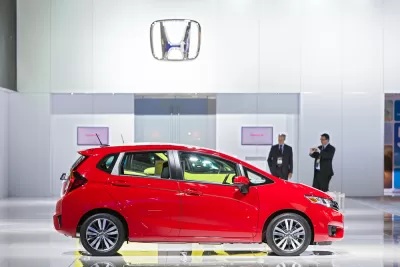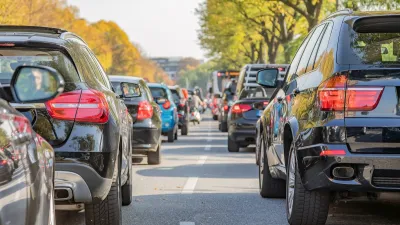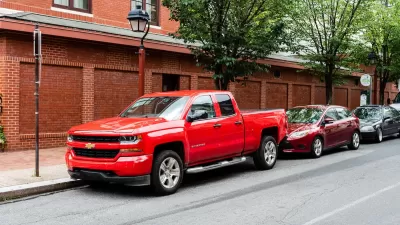Honda recently ended the Fit, a small, affordable subcompact car favored by urban dwellers (like the managing editor of Planetizen). The U.S. car market is now completely dislocated from the reality of the rest of the world.

Aaron Gordon builds a larger narrative after a July announcement by Honda that it would no longer sell the Honda Fit in the United States: car companies are fully committing to a traditional neglect of subcompact offerings in the United States.
The subcompact replacement for the Fit in the Honda fleet will be available in overseas markets, but not in the United States. Moreover, the Fit in the United States was always a downgraded substitute for the bells and whistles, and efficiency, of subcompact vehicles in international markets. Gordon explains:
If you ever want to get upset over the boring, terrible, expensive cars on offer in America, go to the UK version of any automaker’s website. Take Honda, for example. Internationally the Fit is known as the Jazz. In the UK, instead of being killed off, the Jazz got an exciting redesign and is a hybrid. As a result, it’s a little more expensive, but would still likely sell for under $20,000 in the US, which would make it the cheapest hybrid on the market (for Honda models that sell in both countries, the US and UK versions have roughly the same prices in their respective currencies; the Jazz hybrid starts at £19,000).
As noted by Gordon, Honda is far from alone in its lack of quality offerings for subcompact cars in the United States. Volkswagen provides another example.
Gordon also notes at the outset that the "subcompact car is basically dead in the US now"--a bold statement that can be supplemented with a few other recent articles, including an article Erik Shilling about the demise of the Fit that includes the car on the scrap heap of subcompact vehicles history in the U.S. market, including the Chevy Sonic, Ford Fiesta, and Toyota Yaris, among other subcompacts likely to mimic the demise of these articles in the near future.
Americans clearly prefer SUVs and large pickup trucks, as proven by a Wall Street Journal by Dan Neil that provoked the large vehicle-loving community on social media, including Senator Ted Cruz, Republican from Texas. Yet another article on the subject, by Nathanial Bullard, makes the case that another approach to automobile design, growing in popularity in Japan and Europe, would be a better choice for U.S. consumers.
FULL STORY: Do You Live In the US and Want A Small, Affordable Car? Too Bad.

Maui's Vacation Rental Debate Turns Ugly
Verbal attacks, misinformation campaigns and fistfights plague a high-stakes debate to convert thousands of vacation rentals into long-term housing.

Planetizen Federal Action Tracker
A weekly monitor of how Trump’s orders and actions are impacting planners and planning in America.

In Urban Planning, AI Prompting Could be the New Design Thinking
Creativity has long been key to great urban design. What if we see AI as our new creative partner?

King County Supportive Housing Program Offers Hope for Unhoused Residents
The county is taking a ‘Housing First’ approach that prioritizes getting people into housing, then offering wraparound supportive services.

Researchers Use AI to Get Clearer Picture of US Housing
Analysts are using artificial intelligence to supercharge their research by allowing them to comb through data faster. Though these AI tools can be error prone, they save time and housing researchers are optimistic about the future.

Making Shared Micromobility More Inclusive
Cities and shared mobility system operators can do more to include people with disabilities in planning and operations, per a new report.
Urban Design for Planners 1: Software Tools
This six-course series explores essential urban design concepts using open source software and equips planners with the tools they need to participate fully in the urban design process.
Planning for Universal Design
Learn the tools for implementing Universal Design in planning regulations.
planning NEXT
Appalachian Highlands Housing Partners
Mpact (founded as Rail~Volution)
City of Camden Redevelopment Agency
City of Astoria
City of Portland
City of Laramie





























